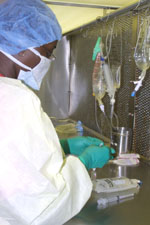Inpatient pharmacy embraces ‘clean
room’
by
Heather WoolwinePublic Relations
MUSC adult inpatient pharmacy takes pride in knowing that the recent renovation to its fourth floor home in the main hospital will improve patient care.
“The decision to add a clean room to inpatient pharmacy was derived from a need to make changes in the environment to make it the very best and safest place possible to prepare sterile solutions,” said Bruce Keck, adult inpatient pharmacy clean room supervisor. “In the microchip industry, all of their work areas are specialized, clean atmospheres. What’s more important, a microchip or IV (intravenous) solution?”
 Laketha Parnell,
adult inpatient pharmacy, prepares sterile IV solutions under a special
hood in the new clean room.
Laketha Parnell,
adult inpatient pharmacy, prepares sterile IV solutions under a special
hood in the new clean room.The new room is also in accordance with changes in federal standards and JCAHO (Joint Commission On Accreditation Of Healthcare Organizations) and OSHA (Occupational Safety and Health Administration) regulations pertaining to the preparation of sterile IV solutions. According to the updated rules, solutions must be prepared in a clean, sterile environment with the ultimate goal of providing patients with a product that they can be rest assured was prepared in the best possible way.
“The intent of the new standards is to decrease as many opportunities as possible for product exposure to sources of contamination,” said Carole Small, R.Ph., adult inpatient pharmacy manager. “I guess the biggest difference is that things are more labor intensive, but we’re really working on becoming more efficient in using the clean room.”
Up and running for only a few weeks, Small is impressed with how well staff members have taken to the new space and procedures.
“There are the gowns, the gloves, and the other garb,” she said. “We’ve had to reallocate our work flow and staffing patterns. There are very stringent cleaning requirements. Through all of the changes, everyone’s been great.”
Small, Keck and several others spent numerous hours researching the most user-friendly cleaning tools; coming up with one that Small refers to as an “industrial model Swiffer.”
Rich Ottmar, adult inpatient pharmacy coordinator, said, “We’re constantly evaluating and upgrading our processes so that training for staff can be more consistent. We’re teaching all inpatient pharmacy staff to work in the clean room, so it’s very important that everyone receive the exact same training.”
Clean room staff must clean floors, ceilings, walls, machines, and products on a weekly or monthly basis, depending on the location within the cleaning room. A red line drawn on the floor of the room separates a clean environment (ante room), from a super clean environment (buffer zone). The buffer zone is behind the line and furthest from the door and pass-through window, which limits contact with outside contaminants. That area is where the sterile products are manipulated.
On one end of the room is a barrier isolation chamber (glove box) which creates a sterile environment to prepare cancer chemotherapy while providing the ultimate protection for the operator. Pass-through boxes for sealed entry into and out of the sterile area help ensure staff safety from exposure to hazardous materials.
In terms of the new hospital replacement project, plans are already under way to include clean rooms in the new facility. In the meantime, planning is under way for the next clean room renovation in the Children's Hospital pharmacy while others are working on a clean room for the Pharmacy Compounding Center.
Friday, Nov. 11, 2005
Catalyst Online is published weekly,
updated
as needed and improved from time to time by the MUSC Office of Public
Relations
for the faculty, employees and students of the Medical University of
South
Carolina. Catalyst Online editor, Kim Draughn, can be reached at
792-4107
or by email, catalyst@musc.edu. Editorial copy can be submitted to
Catalyst
Online and to The Catalyst in print by fax, 792-6723, or by email to
petersnd@musc.edu
or catalyst@musc.edu. To place an ad in The Catalyst hardcopy, call
Community
Press at 849-1778.